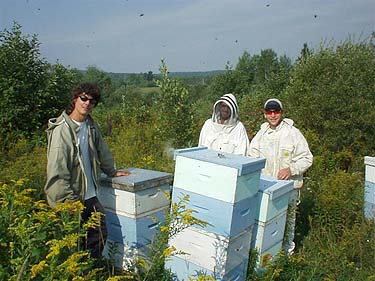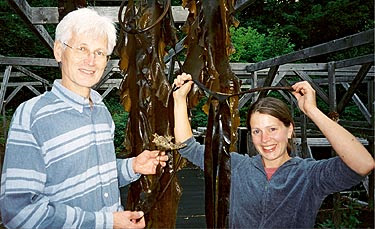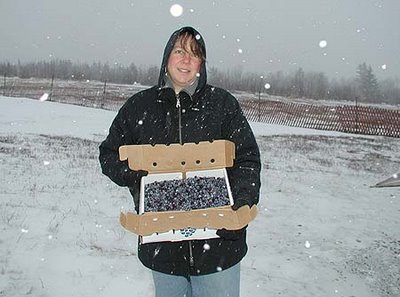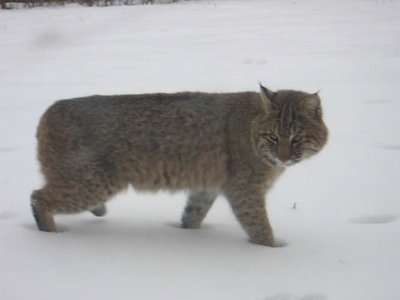balance & equalize …… and the flow is on
Lake Champlain Valley, Vermont
June 21, 2005
Today we celebrate the Summer Solstice, the longest day of the year. At this time, the queen bee will lay the most eggs of the season, this being determined by the number of sunny minutes of the day. Her cycle is in tune with nature and the coming honey flow, as these offspring will become the workers in the season ahead.
After a week of gentle and sometimes heavy rains, the edge has been taken off of the drought, and the sun has returned to our bee yards and the honey house. The flowering nectar plants are abundant now, and their colors are everywhere – the legumes are in bloom, black locust trees dripping with white flowers, purple and hairy vetch, yellow birdsfoot trefoil, pink and white alsike clover, and red clover. This is the earliest crop that we have seen in years.
We have been visiting each bee hive to build bear fences, checking for queens and “balancing and equalizing”, which involves taking frames of brood (young bees before they are adults) from hives that are so strong that they would swarm if they did not have their population cut back (and then not make honey). These frames are given to nucs- new, young colonies that have such a small population (that in their bolstered family strength do make honey this season.) This is the synergy of our work with bees and people, who all contribute different gifts to many common goals.
Because of the time that Sam and Tim have spent with the bees, building them back up in South Carolina and now working with them in the North, they are healthy and strong. The primary support of organic beekeeping are mite resistant bees from Russia and these are being introduced into our colonies as readily as possible.
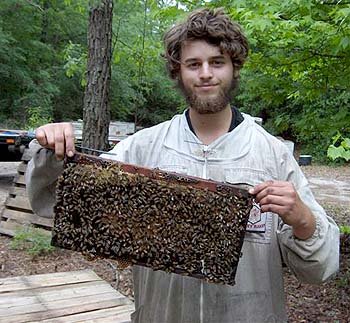
from Russian stock, Crow’s Nest yard
Sam noted this morning at the honey house:
It’s no secret that at Honey Gardens we love bees and want to see them thrive in the North Country like they did before mites and diseases became tremendous stresses. Russian bees love the short intense season that Vermont offers we applaud their winter hardiness, fast buildup, hygienic behavior, and gentleness. They fly at lower temperatures, and above all, they love to make honey. These combined strengths allow us to continue keeping bees without chemical treatments. With each select generation, the bees’ natural defenses are strengthening.
The past week’s rain has put energy into the soil to make the honey flow possible. We have been suspiciously eyeing the basswood trees and wondering if this year the fragile, nectar-rich flowers will not be damaged by thunderstorms. They have not bloomed yet, and as the June weather bounds into hot days, the bees and beekeepers are ready.
We are now shipping the first of the new crop of 2005 honey, raw orange blossom honey from our friends’ bees, made two months ago in Florida, and extracted and bottled in honey house in Vermont. This is a light, delightful raw honey that is very special and is the only raw orange blossom honey that we have ever seen.
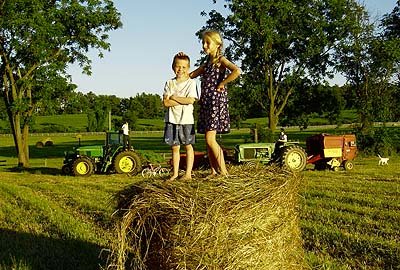
of the first bee yard 40 years ago.
Vermont elderberry project
Lewis Hill talks about elderberry @ the Ferrisburgh honey house 10 AM Saturday July 16 & releases two cultivars from his stock. With elderberry, you may grow plant medicine for your family & friends, feed wildlife, and stabilize the banks of streams from erosion. for info click here
We continue to see how the sum is greater than all of the parts in so much of what we do. Thank you all for your interest in and support of our bees, their work, and plant medicine.

